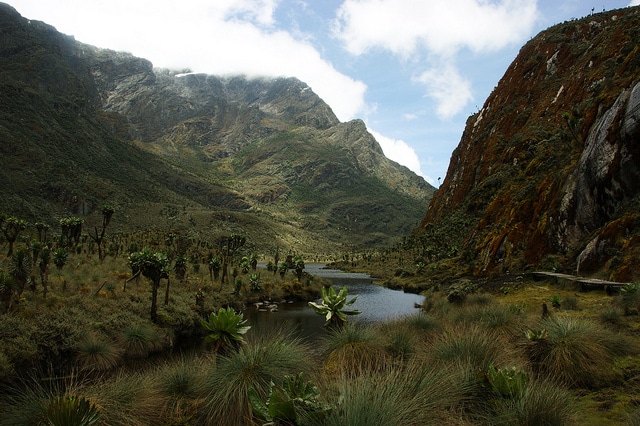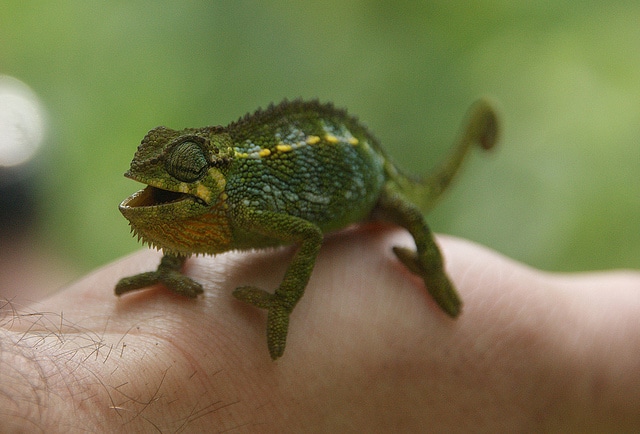On A Mission
Neil and I read a lot about the changes in the mountains before our trek, but we weren’t prepared for just how dramatic those changes would be
Uganda‘s Rwenzori Mountains, with their six distinct peaks and deep gorges, were first summitted in 1906 by the Duke of Abruzzi, with renowned photographer at the time Vittorio Sella capturing beautiful shots of the glacial peaks. Photographing these peaks from the same angle as they were taken on this expedition was the main goal for Dr. Losin and Dr. Dappen, as they wanted to visually document the effects of global warming. Sadly, these glaciers have diminished over 80%, with the prediction being they’ll be completely gone in 20 years. These changes impact the lush flora and impressive biodiversity the Rwenzori Mountains are known for.

“But the Earth’s climate is changing,” Dr. Losin wrote in an article for National Geographic. “Glaciers all over the world are shrinking as the world gets warmer. If we followed in the Duke’s footsteps, a hundred years later, what would we see? My buddy Nate Dappen and I decided we had to find out.”
When trekking through the Rwenzori Mountains it’s impossible not to notice the Dr. Seuss-like landscape, with rare biodiversity, endemic species and flora sprouting in rich patches. A large variety of climates like tropical rainforest, alpine meadow, grasslands, montane cloud forests, afro-alpine moorland, bamboo forest, snowy peaks– along with the heavy rainfall of over 3 meters (9 feet) per year, high altitudes and extreme variances in temperature — allow for an otherworldly scene of lobelias, giant heathers and senecios.
Plants and animals that could previously only survive at certain altitudes can now thrive at higher altitudes, because the temperature is rising at all elevations. These changes in the distribution of plants and animals have major consequences to the environment and to humans.
As you get higher into the mountains, the weather becomes intensely rainy and cloudy, something Dr. Losin and Dr. Dappen had to take into consideration, as it not only made the trek difficult, but also challenged their desire to recreate the shots from 1906. And while the trip didn’t go 100% according to plan, especially as the mountains’ shy nature hidden behind clouds makes it hard to always see their peaks, their efforts weren’t for nothing.
That being said, what they found was extremely alarming.
“Neil and I read a lot about the changes in the mountains before our trek, but we weren’t prepared for just how dramatic those changes would be,” explains Dr. Dappen. “For example, one of the huts we stayed in on Mt. Stanley would have been covered by over a hundred feet of ice during the 1906 expedition that we were retracing. The numerous glacial lakes that had formed in just the last century also astonished us. Further, some of the routes that our guides took climbers on just a year before our expedition no longer existed. Another shock was seeing many of the amazing plants and animals of the Rwenzori’s thousands of feet higher than they could survive just a few decades ago. The list goes on and on. Despite all the change, these mountains are still spectacular. If you have the time, it’s worth visiting this place before the glaciers disappear completely.”
Can The Damage Be Reversed?
According to Dappen, it takes thousands of years for glaciers to form, occurring when more snow falls than can melt. As it accumulates, the snow is compressed into ice. Because it’s such a slow process for glaciers to form it would take many thousands of years before the Rwenzori Glaciers could be restored — and that’s if there were even ideal conditions.
These melting glaciers aren’t the only symptom of climate change in the Rwenzori Mountains, but also shifts in wildlife patterns.
“Plants and animals that could previously only survive at certain altitudes can now thrive at higher altitudes, because the temperature is rising at all elevations,” says Dr. Dappen. “These changes in the distribution of plants and animals have major consequences to the environment and to humans. One scary example of this is with mosquitoes. Mosquitoes carry a parasite that causes malaria. Ibanda, the mountain village where climbers start their hike into the Rwenzori’s, used to be too high for mosquitoes to survive. Historically, residents of Ibanda never experienced malaria. But in the last half century, the climate has warmed enough for mosquitos to invade higher altitudes. Malaria is now common in high elevation villages like Ibanda.”
This is important to consider, because although it’s not possible to restore the Rwenzori Glaciers we can work to stabilize the climate and avoid other problems like this from happening in the future.

The Bakonjo People
While it’s sad to think future generations may never get to see these unique mountains in person, most directly affected by the melting ice are the Bakonjo people. These people not only call these mountains home, but associate religious meaning to them, as well. “Rwenzori” literally means “rainmaker,” and these mountains’ ability to bring heavy rains to the area allows them to create new life. If you are so lucky to get the opportunity to climb the Rwenzori Mountains it is the Bakonjo people that will be your guides.
How You Can Help
While we can’t reverse the negative impact we’ve had on the Rwenzori Glaciers to date, there are changes we can make in our behaviors now to help preserve what’s left of our beautiful world. A few to start with:
Even though the Rwenzori glaciers may not be here for long, we can still learn from them. One of those lessons is that our actions, good or bad, are affecting places and people that we have never heard of.
- Lessen your carbon footprint during your commute. Walk or cycle if you can, or opt for public transit. If you must drive, try carpooling.
- Make changes in your diet and start buying organic, locally-grown foods as much as possible.
- Compost organic matter and recycle glass, plastic and aluminum.
- When traveling, stay in one city as much as possible (slow travel) and opt for eco-friendly accommodations.
- Get involved with organizations working to make the planet greener, and help educate the general public.
Dr. Dappen also has a suggestion. “I think that the most important thing that people can do, is to support their representatives in congress to implement legislation that addresses climate change. Climate change is such a volatile political subject that most politicians are scared to touch it. Let your representatives know that climate change is an issue that’s important to you and that you’ll support their efforts to address it.”
Takeaway Points
Human activities are affecting every part of the planet, and it’s time for people to start thinking more about how their actions are impacting others and the world. What’s really shocking about the melting Rwenzori Glaciers is that their disappearance is the result of human behavior happening on other continents, especially from industrialized countries. So despite the fact Uganda has little to do with climate change, they’re suffering from it on a large scale.
“One of the most common responses we’ve gotten from our film Snows of the Nile is “I didn’t even know those mountains existed!,” says Dr. Dappen. “Even though the Rwenzori glaciers may not be here for long, we can still learn from them. One of those lessons is that our actions, good or bad, are affecting places and people that we have never heard of. I think that taking this into account makes me feel like more a part of the global community and encourages me to be a better member of the community.”

The Stay Thirsty Grant
The Rwenzori Mountains expedition spearheaded by Dr. Losin and Dr. Dappen was made possible by Dos Equis’ Stay Thirsty Grant. With the grant, $25,000 is awarded to the person or team with an idea for a globally-inspiring adventure. Have an idea on how to educate or change the world and need help making it happen?
And to learn more about the devastating effects global warming is having on Rwenzori Mountains and see footage from the Stay Thirsty expedition, check out the trailer at the top of the post (to see full video you must purchase for $2.99).
Featured image via Jorn Eriksson

Jessica Festa is the editor of the travel sites Jessie on a Journey (http://jessieonajourney.com) and Epicure & Culture (http://epicureandculture.com). Along with blogging at We Blog The World, her byline has appeared in publications like Huffington Post, Gadling, Fodor’s, Travel + Escape, Matador, Viator, The Culture-Ist and many others. After getting her BA/MA in Communication from the State University of New York at Albany, she realized she wasn’t really to stop backpacking and made travel her full time job. Some of her most memorable experiences include studying abroad in Sydney, teaching English in Thailand, doing orphanage work in Ghana, hiking her way through South America and traveling solo through Europe. She has a passion for backpacking, adventure, hiking, wine and getting off the beaten path.








